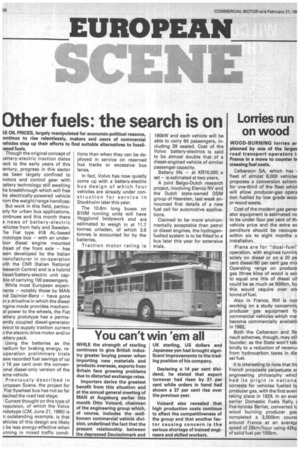Other fuels: the search is on
Page 64

If you've noticed an error in this article please click here to report it so we can fix it.
‘S OIL PRICES, largely manipulated for economic-political reasons, :ontinue to rise relentlessly, makers and users of commercial rehicles step up their efforts to find suitable alternatives to fossil)ased fuels.
Though the original concept of )attery-electric traction dates )ack to the early years of this :entury, progress in this sector as been largely confined to notors and control gear with )attery technology still awaiting he breakthrough which will free he electrically-powered vehicle rom the weight/range handicap. But work in this field, particuarly for urban bus applications, ontinues and this month there s news of battery-electric 'ehicles from Italy and Sweden. he Fiat type 418 AL-based Kototype bus — with an underIcor diesel engine mounted head of the front axle -has leen developed by the Italian nanufacturer in co-operation vith the CNR (Italian National lesearch Centre) and is a hybrid liesel/battery-electric unit capble of carrying 100 passengers. While most European experinents — notably those by MAN nd Daimler-Benz — have gone jr a driveline in which the diesel ngine mode provides mechanial power to the wheels, the Fiat lottery prototype has a permaiently coupled diesel-generator 3yout to supply traction current
D the electric drive motor and/or ,attery pack,
Using the batteries as the iedium for braking energy, reuperation preliminary trials ave recorded fuel savings of up D 16 per cent over the convenonal diesel-only version of the ame vehicle.
Previously described in uropean Scene, the project for Fiat flywheel bus has not so far E.' ached the road test stage.
Current thought on this type of ropulsion, of which the Volvo rototype (CM, June 21, 1980) is n outstanding example, is that ehicles of this design are likely ) be less energy-effective when .Inning in mixed traffic condi tions than when they can be deployed in service on reserved bus tracks or excessive bus lanes.
In fact, Volvo has now quietly come up with a battery-electric bus design of which four vehicles are already under construction for service in Stockholm later this year.
The 10.8m long buses on B10M running units will have Hogglund bodywork and are estimated to weigh in at 11.7 tonnes unladen, of which 3.6 tonnes is accounted for by the batteries.
Traction motor rating is 180kW and each vehicle will be able to carry 64 passengers, including 39 seated. Cost of the Volvo battery-electncs is said to be almost double that of a diesel-engined vehicle of similar passenger capacity.
Battery life — at KR70,000 a set — is estimated at two years.
A joint Belgo-Dutch research project, involving Elenco NV and the Dutch state-owned DSM group of Heerelen, last week announced first details of a new fuel cell for automotive applications.
Claimed to be more environmentally acceptable than petrol or diesel engines, the hydrogenfuelled system is to be fitted to a bus later this year for extensive trials.
































































































